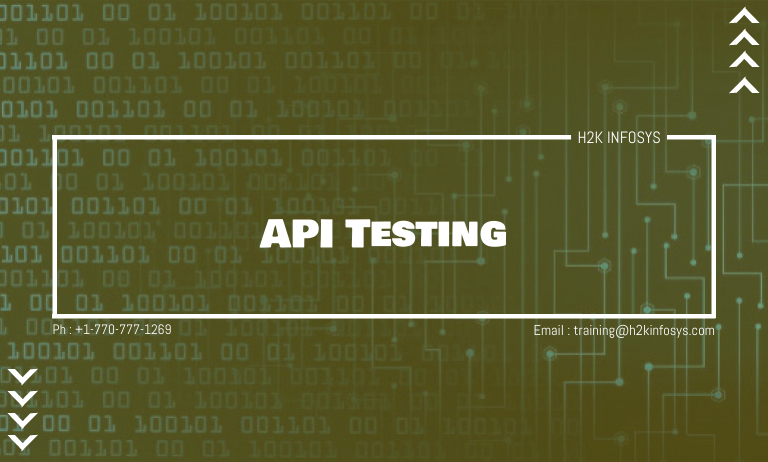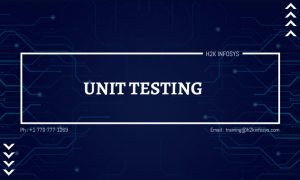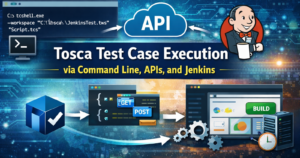API stands for Application Programming Interface which mentions how one component should interact with other. It consists of set of routines, protocols and tools for building the software applications.
What is API Testing?
The API testing is performed for mainly system which has the collection of programming interfaces. When testing we consider some of the below aspects:
- By exploring boundary conditions and also making sure that the test harness which has various parameters of the API calls in ways that verify functionalities and failures.
- Generating very large value added parameter combinations to verify the calls with two or more parameters.
- Verify the behaviour of the API which considers the external environment conditions like as files, peripheral devices and so forth.
Types of output of an API:
An output of an API:
- Any type of data
- Status(pass or Fail)
- Call another API function
For example:
- Any type of data
There will be an API function which should add two integer numbers
Long add (int a, int b)
The numbers that have been given as input parameters. The output should be a summation of two integer numbers. This output needs a verification with an expected outcome.
The function has to be called as:
add (1234, 5656)
- Status (say pass/fail)
Consider the below API functions
- Lock()
- Unlock()
- delete()
They actually return value such as true (in case of success) or false(in case of error) as an output.
- Call another API function
A more accurate Test suite is going to be a call to the functions in any scripts and should be later checked for the changes either within the database or could also be application GUI.
Test cases for an API testing:
Test cases for an API are based on:
- Return value based on the input condition: it is relatively easy to test, as input which can be explained and results can be authenticated.
- Doesn’t return anything: When there is no return value, a behaviour of API system has to be checked.
- Trigger some other API/event/interrupt: if an output of an API triggers some event or interrupt then those events and interrupt listeners will be tracked.
- Update data structure: Updating data structure will have some outcome or either system will be authenticated.
- Modify certain resources: If API call changes some resources, then it will be validated by accessing respective resources.
API testing Approach:
An API testing approach is a defined strategy or a method that the QA Testing team will perform in order to conduct the API testing after the build will be ready. This testing does not include the source code. The API testing approach helps to understand the functionalities, testing technique, input parameters and therefore execution of test cases.
Challenges in API testing:
Challenges faced by API testing are:
- Main challenges in web API testing are parameter combination, parameter selection and call sequencing.
- There is no GUI available to test the application which makes difficult to give input values.
- validating and also verifying the output in a different system is little difficult specially for testers
- Exception handling functions need to be tested
- coding knowledge is necessary for testers.


























9 Responses
API stands for Application Programming Interface which mentions how one component should interact with other. The API testing is performed for mainly system which has the collection of programming interfaces. An output of an API include Any type of data, Status(pass or Fail) and Call another API function. Test cases for an API are based on:
1. Return value based on the input condition: it is relatively easy to test, as input which can be explained and results can be authenticated.
2. Doesn’t return anything: When there is no return value, a behavior of API system has to be checked.
3. Trigger some other API/event/interrupt: if an output of an API triggers some event or interrupt then those events and interrupt listeners will be tracked.
4. Update data structure: Updating data structure will have some outcome or either system will be authenticated.
5. Modify certain resources: If API call changes some resources, then it will be validated by accessing respective resources.
The API testing approach helps to understand the functionalities, testing technique, input parameters and therefore execution of test cases. Challenges in API testing is also mentioned.
API stands for Application Programming Interface which mentions how one component should interact with other. It consists of set of routines, protocols and tools for building the software applications.
The API testing is performed for mainly system which has the collection of programming interfaces. When testing we consider some of the below aspects:
By exploring boundary conditions and also making sure that the test harness which has various parameters of the API calls in ways that verify functionalities and failures.
Generating very large value-added parameter combinations to verify the calls with two or more parameters.
Verify the behavior of the API which considers the external environment conditions like as files, peripheral devices and so forth.
Types of output of an API:
An output of an API:
Any type of data
Status (pass or Fai l)
Call another API function
API testing Approach:
An API testing approach is a defined strategy or a method that the QA team will perform in order to conduct the API testing after the build will be ready. This testing does not include the source code. The API testing approach helps to understand the functionalities, testing technique, input parameters and therefore execution of test cases.
There are some Challenges faced by API testing like the challenges in web API testing are parameter combination, parameter selection and call sequencing.
There is no GUI available to test the application which makes difficult to give input values.
validating and also verifying the output in a different system is little difficult specially for testers
Exception handling functions need to be tested
coding knowledge is necessary for testers.
API stands for Application Programming Interface which mentions how one component should interact with other. It consists of set of routines, protocols and tools for building the software applications.
What is API Testing?
The API testing is performed for mainly system which has the collection of programming interfaces. When testing we consider some of the below aspects:
By exploring boundary conditions and also making sure that the test harness which has various parameters of the API calls in ways that verify functionalities and failures.
Generating very large value added parameter combinations to verify the calls with two or more parameters.
Verify the behaviour of the API which considers the external environment conditions like as files, peripheral devices and so forth.
Types of output of an API:
An output of an API:
*Any type of data
*Status(pass or Fail)
*Call another API function
API testing Approach:
An API testing approach is a defined strategy or a method that the QA team will perform in order to conduct the API testing after the build will be ready. This testing does not include the source code. The API testing approach helps to understand the functionalities, testing technique, input parameters, and therefore execution of test cases.
Challenges faced by API testing are:
Main challenges in web API testing are parameter combination, parameter selection and call sequencing.
*There is no GUI available to test the application which makes difficult to give input values.
*validating and also verifying the output in a different system is little difficult specially for testers
*Exception handling functions need to be tested
*coding knowledge is necessary for testers.
Application Programming (API) Interface which mentions how one component should interact with other. It is set of routines, protocols and tools for building the software applications.
The API testing is performed for mainly system which has the collection of programming interfaces. When testing we consider some of the below aspect.
Types of output of an API:
1.Any type of data
2.Status(pass or Fail)
3.Call another API function
Test cases for an API testing:
1. Return value based on the input condition: it is relatively easy to test, as input which
can be explained and results can be authenticated.
2. Doesn’t return anything: When there is no return value, a behaviour of API system
has to be checked.
3.Trigger some other API/event/interrupt: if an output of an API triggers some event or
interrupt then those events and interrupt listeners will be tracked.
4.Update data structure: Updating data structure will have some outcome or either
system will be authenticated.
5.Modify certain resources: If API call changes some resources, then it will be
validated by accessing respective resources.
Challenges faced by API testing are:
1. Main challenges in web API testing are parameter combination, parameter selection
and call sequencing.
2.There is no GUI available to test the application which makes difficult to give input
values.
3.validating and also verifying the output in a different system is little difficult specially
for testers
4.Exception handling functions need to be tested
coding knowledge is necessary for testers
API stands for Application Programming Interface which mentions how one component should interact with other. It consists of set of routines, protocols and tools for building the software applications.The API testing is performed for mainly system which has the collection of programming interfaces. An API testing approach is a defined strategy or a method that the QA team will perform in order to conduct the API testing after the build will be ready. This testing does not include the source code. The API testing approach helps to understand the functionalities, testing technique, input parameters and therefore execution of test cases.
When API testing we consider some of the below aspects:
By exploring boundary conditions and also making sure that the test harness which has various parameters of the API calls in ways that verify functionalities and failures.
Generating very large value added parameter combinations to verify the calls with two or more parameters.
Verify the behaviour of the API which considers the external environment conditions like files, peripheral devices and so forth.
API testing
API stands for Application Programming Interface which mentions how one component should interact with other. It is set of routines , protocols and tools for building an application.
Aspects considered while API testing is done are :
1. Boundary value conditions
2. Generating very Large value parameters
3. Checking behavior of API
Types of outputs of an API
1. Any type of data
2. Status (pass or fail)
3. Call out another API function
Test cases for an API based on:
1. Return value based on the input condition,as input which can be explained and results can be authenticated.
2. Doesn’t return anything.
3. Trigger some other API/event/interrupt
4. Update data structure
5. Modify certain resources
API stands for Application Programming Interface which mentions how one component should interact with other. It consists of set of routines, protocols and tools for building the software applications.The API testing is performed for mainly system which has the collection of programming interfaces. An API testing approach is a defined strategy or a method that the QA team will perform in order to conduct the API testing after the build will be ready. This testing does not include the source code. The API testing approach helps to understand the functionalities, testing technique, input parameters and therefore execution of test cases.
When API testing we consider some of the below aspects:
By exploring boundary conditions and also making sure that the test harness which has various parameters of the API calls in ways that verify functionalities and failures.
Generating very large value added parameter combinations to verify the calls with two or more parameters.
Verify the behaviour of the API which considers the external environment conditions like files, peripheral devices and so forth.
API stands for Application Programming Interface which mentions how one component should interact with other. It consists of set of routines, protocols and tools for building the software applications.
What is API Testing?
The API testing is performed for mainly system which has the collection of programming interfaces. When testing we consider some of the below aspects:
By exploring boundary conditions and also making sure that the test harness which has various parameters of the API calls in ways that verify functionalities and failures.
Generating very large value added parameter combinations to verify the calls with two or more parameters.
Verify the behaviour of the API which considers the external environment conditions like as files, peripheral devices and so forth.
Types of output of an API:
An output of an API:
Any type of data
Status(pass or Fail)
Call another API function